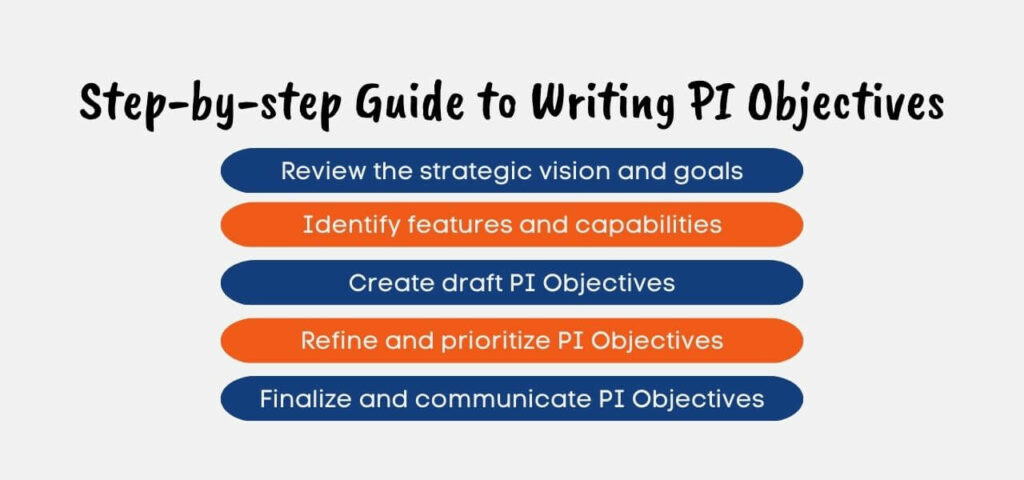PI Objectives, or Program Increment Objectives, are a crucial component of the Scaled Agile Framework (SAFe), which is a framework designed to help organizations achieve their goals by implementing Lean and Agile principles.
In this blog post, we’ll take a deep dive into the world of SAFe PI Objectives, discussing what they are, why they’re important, and how to create them effectively.
We’ll also provide a step-by-step guide on writing PI Objectives and share some best practices that will help your organization succeed.
What Are PI Objectives?
A Program Increment (PI) is a time-boxed period, typically lasting 8-12 weeks, during which an Agile Release Train (ART) delivers a set of features or capabilities.
PI Objectives are a summary of the business and technical goals that the ART aims to achieve during a given PI and are like a bridge between the strategic vision of the organization and the day-to-day work of the Agile teams.
PI Objectives are typically created during the PI Planning event, a two-day collaborative session where teams come together to align their priorities, plan their work, and establish a shared understanding of the objectives they’re working towards.

The Importance of PI Objectives
PI Objectives play a crucial role in the SAFe framework, as they:
- Align teams with business strategy: By translating the company’s strategic vision into tangible goals, PI Objectives ensure that the work being carried out by the Agile teams is directly aligned with the organization’s overall objectives.
- Drive collaboration and communication: PI Objectives foster collaboration between teams, enabling them to work together more effectively and ensuring that the ART is delivering value in a cohesive manner.
- Provide a basis for decision-making: By clearly stating the goals for a given PI, PI Objectives help teams prioritize their work and make informed decisions about which features or capabilities to focus on.
- Enable measurement of progress: PI Objectives serve as a basis for evaluating the success of the ART during the Inspect and Adapt (I&A) event at the end of the PI. This allows teams to assess their performance, identify areas for improvement, and adjust their approach accordingly.
Creating Effective PI Objectives
Now that we understand the importance of PI Objectives, let’s discuss how to create them effectively. Here are some tips to help you get started:
1. Keep them SMART
The most effective PI Objectives are SMART, meaning they are Specific, Measurable, Achievable, Relevant, and Time-bound. A SMART objective is clear and concise, leaving no room for ambiguity or misunderstanding.
It should be quantifiable, so progress can be easily tracked, and it should be realistic, so the team isn’t setting itself up for failure.
2. Align with the Strategic Vision
Ensure that your PI Objectives are aligned with the organization’s strategic vision and goals.
This will help ensure that the work being done by the Agile teams is contributing to the success of the company as a whole.
3. Be Customer-centric
PI Objectives should focus on delivering value to the customer. Keep the end user in mind when creating your objectives, and consider how the features or capabilities being developed will improve the customer experience or solve their problems.
4. Balance Business and Technical Objectives
It’s essential to strike a balance between business and technical objectives. While it’s important to deliver value to the customer, it’s also necessary to invest in the underlying technology and infrastructure that supports your products and services.
This may include improving system performance, addressing technical debt, or enhancing security measures.

Step-By-Step Guide to Writing PI Objectives
Now that we’ve covered the basics, let’s walk through the process of writing PI Objectives:
- Review the strategic vision and goals: Begin by examining the organization’s strategic vision and goals for the upcoming PI. This will help you align your PI Objectives with the company’s overall direction.
- Identify features and capabilities: Next, identify the features and capabilities that your Agile teams will be working on during the upcoming PI. This may include new features, enhancements to existing features, or addressing technical debt.
- Create draft PI Objectives: Using the features and capabilities identified in the previous step, create a draft of your PI Objectives. Remember to keep them SMART, customer-centric, and balanced between business and technical objectives.
- Refine and prioritize PI Objectives: Collaborate with your team to refine and prioritize the PI Objectives. This may involve making adjustments based on feedback, as well as determining which objectives are most important for the upcoming PI.
- Finalize and communicate PI Objectives: Once your PI Objectives have been refined and prioritized, finalize them and share them with the entire Agile Release Train. This will ensure everyone is on the same page and working towards the same goals.
Best Practices for PI Objectives
To maximize the benefits of PI Objectives, keep these best practices in mind:
- Involve the entire team: The process of creating PI Objectives should be a collaborative effort, involving input from all team members.
This helps to ensure that everyone is invested in the objectives and understands how their work contributes to the overall goals. - Keep it visible: Display your PI Objectives in a prominent location, such as a team workspace or digital collaboration tool.
This will serve as a constant reminder of the goals your team is working towards and help maintain focus and alignment throughout the PI. - Regularly review progress: To ensure that your PI Objectives are on track, it’s important to regularly review progress against the objectives.
This can be done during team meetings, where team members can provide updates on their work and discuss any obstacles or challenges they’re facing. - Adjust as needed: PI Objectives should not be set in stone. If circumstances change or new information becomes available, it may be necessary to adjust your objectives accordingly.
Be prepared to make changes and adapt your objectives as needed to ensure they remain relevant and achievable. - Learn from previous PIs: At the end of each PI, during the Inspect and Adapt (I&A) event, take the time to review your PI Objectives and assess your team’s performance.
Use this information to identify areas for improvement and inform the creation of PI Objectives for the next PI.

How Do Business Owners Quantify the Value of PI Objectives?
Business owners should quantify the value of PI Objectives to determine if they are worthwhile and driving real business benefits. Some ways to measure value include:
- Increased revenue or profit: If a PI Objective is to optimize pricing or expand to new markets, measure impact on sales and margins.
- Cost savings: For a PI Objective around reducing churn or optimizing operations, track cost reductions and efficiency gains.
- Customer metrics: For a PI Objective targeting customer experience, measure satisfaction, retention, word-of-mouth ratings to gauge value.
- Market share: For a PI Objective to release new products or out-innovate competitors, assess if it helped gain market share.
- Productivity or cycle time: For internally-focused PI Objectives around improving processes or capabilities, quantify impact on lead or development times.
- Employee metrics: For culture-related PI Objectives, measure employee engagement, retention or satisfaction scores to determine value.
While not all benefits may be quantifiable, data around the objectives should demonstrate a positive trend.
If unable to measure clear business value, question whether the right objectives are being set and pivot as needed. Metrics aligned to objectives help create a data-driven culture of continuous improvement.
PI Objectives vs Sprint Goals
PI Objectives are high-level targets set for a Program Increment (PI) planning cycle, typically 8-12 weeks. They focus on the key business and technical outcomes to achieve.
Sprint Goals, on the other hand, are specific targets set for each 1-2 week sprint. They are tangible and focused on incremental progress toward the PI Objectives.
While PI Objectives provide vision and direction, Sprint Goals enable execution. For example, a PI Objective may be “Launch new website”. The Sprint Goals would then be:
- Sprint 1: Design homepage
- Sprint 2: Build homepage
- Sprint 3: Create content pages
- Sprint 4: Testing and fixes
- Sprint 5: Deploy to production
PI Objectives give the why, while Sprint Goals give the what and how. Both need to be clear, measurable, and driven from business value.
Syncing them together through regular feedback loops is key to successful Agile delivery.

PI Objectives vs Features
Features refer to the specific product functionality that provides value to customers and users. PI Objectives, on the other hand, are high-level aims set for a Program Increment planning period to meet key business and technical goals.
While features are an output, PI Objectives shape the outputs.
For example, a PI Objective may be “Increase customer renewal rate by 20%”. The features that could contribute to achieving this may include:
- Auto-renew subscription option
- Usage stats dashboard
- Recommendation engine
The features are the means to the end which is the PI Objective. They should be prioritized and selected based on how well they serve the key objectives.
Not all potential features may be worked on in a PI. PI Objectives help set the direction and constraints within which features are identified, discussed, and delivered.
Features answer the “what” whereas PI Objectives define the “why”. Strong alignment between the two, enabled through frequent re-planning and feedback loops, is fundamental to building high-value products.
Conclusion
PI Objectives are a critical component of the Scaled Agile Framework, helping to align Agile teams with the strategic vision and goals of the organization.
By creating effective PI Objectives that are SMART, customer-centric, and balanced between business and technical objectives, you can ensure that your Agile Release Train is working cohesively to deliver value to your customers.
Remember to involve your entire team in the process of creating PI Objectives, keep them visible, regularly review progress, adjust as needed, and learn from previous PIs to continuously improve your approach.
By following these steps and best practices, your organization will be well on its way to achieving its goals and realizing the full benefits of the SAFe framework.
FAQs
What are Good PI Objectives?
Good PI objectives are specific, measurable, achievable, relevant, and time-bound. They focus on observable outcomes, not methods.
Metrics and targets should be meaningful to customers and staff. Strong objectives align with strategic goals, are contextualized, and consider external factors.
They inspire action and are flexible as situations change. Well-designed objectives drive progress, accountability, and continual learning.
Who is Responsible for PI Objectives in Agile?
In Agile, cross-functional teams drive PI objectives. Product Owners convey customer needs, but teams determine how to meet them.
Teams commit to iterative objectives and are mutually accountable for results. Shared responsibility engages diverse expertise, distributes work, and empowers teams to self-organize. Collective ownership and transparency achieve high-impact outcomes in a flexible, motivating environment.
What is a Benefit of PI Objectives?
PI objectives align teams to deliver value in short iterations. This focuses work, reduces waste, and ensures transparency. Overall, PI Objectives improve business agility.
Who Decides the Team PI Objective Business Value?
The Product Owner prioritizes features by business value and ROI. With input from key stakeholders and the team, the Product Owner determines the objectives for each Program Increment to maximize value delivery.
What Should PI Objectives be Based On?
PI objectives should be based on customer and business needs, not outputs. They focus on outcomes and impacts, not features.
Objectives must be specific, measurable, achievable, relevant and time-bound. They align the team to common goals to build successful increments that deliver maximum value.





